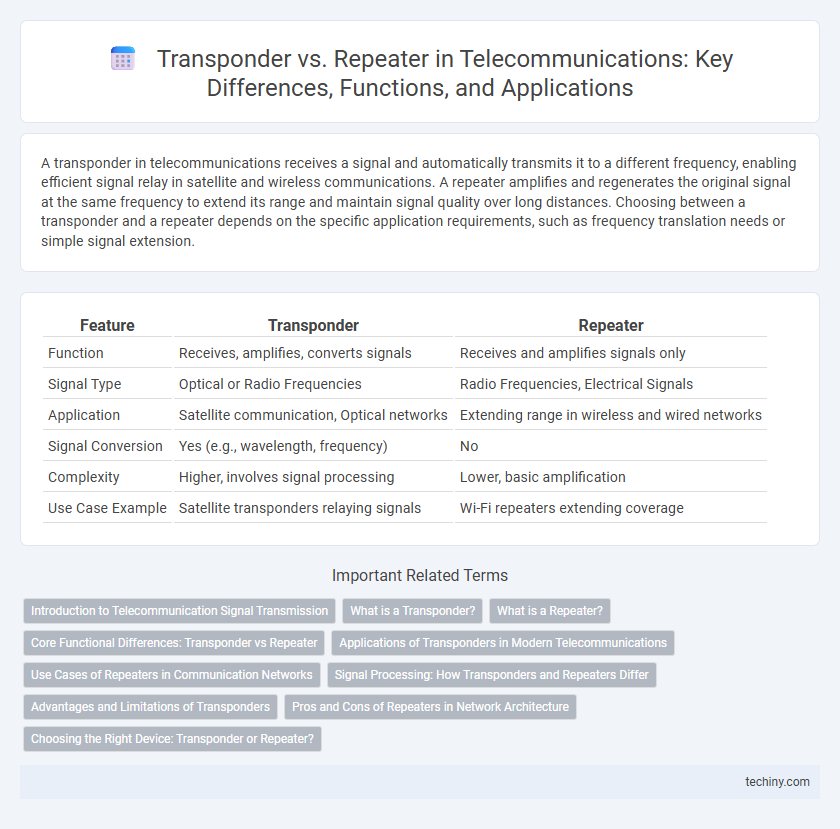A transponder in telecommunications receives a signal and automatically transmits it to a different frequency, enabling efficient signal relay in satellite and wireless communications. A repeater amplifies and regenerates the original signal at the same frequency to extend its range and maintain signal quality over long distances. Choosing between a transponder and a repeater depends on the specific application requirements, such as frequency translation needs or simple signal extension.
Table of Comparison
| Feature | Transponder | Repeater |
|---|---|---|
| Function | Receives, amplifies, converts signals | Receives and amplifies signals only |
| Signal Type | Optical or Radio Frequencies | Radio Frequencies, Electrical Signals |
| Application | Satellite communication, Optical networks | Extending range in wireless and wired networks |
| Signal Conversion | Yes (e.g., wavelength, frequency) | No |
| Complexity | Higher, involves signal processing | Lower, basic amplification |
| Use Case Example | Satellite transponders relaying signals | Wi-Fi repeaters extending coverage |
Introduction to Telecommunication Signal Transmission
Transponders and repeaters play crucial roles in telecommunication signal transmission by ensuring signal integrity and distance coverage. A transponder receives an incoming signal, amplifies it, converts its frequency, and retransmits it, commonly used in satellite communication to manage multiple channels efficiently. Repeaters amplify and regenerate weakened signals without frequency conversion, extending the reach of fiber optic or wireless networks while maintaining signal quality.
What is a Transponder?
A transponder in telecommunications is an electronic device that receives a signal on one frequency, amplifies or processes it, and retransmits it on another frequency, commonly used in satellite communication to relay signals between the ground and space. It performs frequency translation and signal regeneration, ensuring minimal loss and interference over long distances. Unlike repeaters that simply amplify signals on the same frequency, transponders enable effective signal routing by changing the transmission frequency.
What is a Repeater?
A repeater is a telecommunications device that receives a signal, amplifies it, and retransmits it to extend the transmission distance in communication networks. It is essential for overcoming signal attenuation and maintaining signal strength over long fiber optic cables or wireless links. Unlike transponders, repeaters operate at the electrical or optical level without converting the signal into another form.
Core Functional Differences: Transponder vs Repeater
A transponder in telecommunications receives a signal, amplifies it, converts its frequency, and retransmits it, primarily used in satellite communication to manage signal channels. In contrast, a repeater solely amplifies and regenerates the received signal without frequency conversion, extending the range of wired or wireless communication systems. The core functional difference lies in the transponder's signal frequency translation capability versus the repeater's role in pure signal amplification and regeneration.
Applications of Transponders in Modern Telecommunications
Transponders are essential in satellite communications for frequency translation and signal amplification, enabling long-distance data transmission with minimal loss. They facilitate efficient bandwidth utilization and support complex modulation schemes, critical for modern broadband and mobile networks. Transponders also play a key role in optical fiber systems, converting and regenerating signals to maintain high-speed data integrity across vast distances.
Use Cases of Repeaters in Communication Networks
Repeaters play a critical role in communication networks by amplifying and retransmitting signals to extend the transmission distance without degradation. Common use cases include boosting signals in fiber optic networks, expanding coverage in wireless communication systems, and enhancing signal strength in long-haul microwave links. By regenerating weakened signals, repeaters ensure reliable data transmission across large geographic areas where direct communication is infeasible.
Signal Processing: How Transponders and Repeaters Differ
Transponders and repeaters both amplify signals but differ significantly in signal processing complexity; transponders demodulate, regenerate, and retransmit the signal with improved integrity, while repeaters simply amplify and rebroadcast the incoming signal without altering its form. Transponders perform error correction and protocol conversion, making them essential for long-distance fiber optic and satellite communications. Repeaters are typically used in shorter-range applications to maintain signal strength by boosting attenuation-prone transmissions.
Advantages and Limitations of Transponders
Transponders enhance signal integrity by receiving, amplifying, and retransmitting signals with frequency conversion, allowing for efficient long-distance telecommunications and multiplexing of multiple channels. Their advantage lies in reducing noise accumulation and enabling precise frequency management compared to repeaters, which simply regenerate signals on the same frequency. Limitations of transponders include higher complexity, cost, and power consumption, and potential latency due to signal processing steps.
Pros and Cons of Repeaters in Network Architecture
Repeaters amplify and regenerate signals in network architecture, extending transmission distance without significant signal degradation. They are cost-effective and simple to deploy but lack the capability to filter or process data, potentially leading to noise amplification and reduced efficiency in complex networks. Repeaters are ideal for short to medium-range communication but are less effective in large-scale systems where advanced signal management is required.
Choosing the Right Device: Transponder or Repeater?
Choosing the right device between a transponder and a repeater depends on the specific needs of your telecommunications setup. A transponder efficiently receives, amplifies, and retransmits signals, often converting them to a different frequency to avoid interference and extend communication range. In contrast, a repeater primarily amplifies and retransmits the same frequency signal to boost coverage without altering the signal type, making it ideal for simple range extension in wireless networks.
Transponder vs Repeater Infographic

 techiny.com
techiny.com